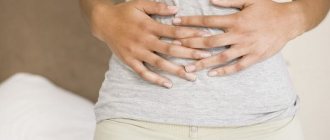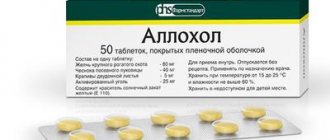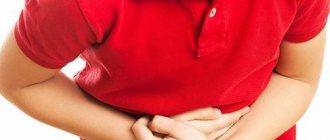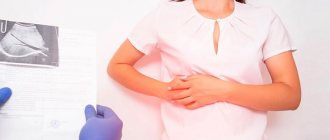Any disruption of the internal secretion organs in children can lead to subsequent disruptions in the functioning of the endocrine system, the occurrence of inflammatory diseases of the gastrointestinal tract and or bone tissue, delayed or premature puberty.
An enlarged gallbladder leads to changes in the amount and concentration of bile entering the small intestine. The result is dysbacteriosis, stagnation of feces, constant bloating or damage to the mucous membrane due to high acidity (gastritis, ulcers, colitis).
Stagnation of bile in the organ leads to inflammatory and or purulent processes in the gallbladder, bile ducts, liver, and in childhood – pathology of the abdominal organs.
How does the gallbladder work in children?
The structure and function of the gallbladder
When food passes through the ileum of the small intestine, the receptors of its walls give a signal, after receiving which the gallbladder contracts, releasing into the small intestine what is necessary to digest the given amount and composition of food.
The main functions of bile are the breakdown of fats and reduction of food acidity. Bile consists of lecithin (the simplest phospholipids), bile acids and minerals, mainly calcium.
The normal volume of the gallbladder depends on age.
| In a newborn | 34 by 10 mm. |
| 1-5 months | 40 by 11 mm. |
| 6-12 months | 48 by 13 mm. |
| 1-2 years | 50 by 16 mm. |
| 2-5 years | 50 by 17 mm. |
| 6-8 years | 61 by 18 mm. |
| 9-11 years | 64 by 23 mm. |
| 12-16 years old | 65 by 25 mm. |
Deviations from the norm are allowed up to 2 mm.
Functional disorders of the biliary system in children
Biliary dyskinesia is a classic representative of functional disorders (diseases) of the gastrointestinal tract. The modern definition, according to DA Drossman, is that “functional impairment is a varied combination of gastrointestinal symptoms without structural or biochemical abnormalities.” Functional diseases include conditions in which it is not possible to detect morphological, genetic, metabolic and other changes in organs. Functional pathological syndromes arise as a result of violations of the mechanisms regulating the functions of a particular organ or system. Disorder of the motor-tonic function of the biliary tract - or dyskinesia of the biliary system - is one of the most common diseases in childhood. Violation of the outflow of bile or its irregular flow into the intestinal lumen affects not only the functioning of the digestive tract, but also the entire organism as a whole, since bile, being a multicomponent biochemical substrate, provides a number of functional processes. These include the following: neutralization of hydrochloric acid and pepsin, emulsification of fats and thereby participation in their hydrolysis, activation of intestinal and pancreatic enzymes, enhanced absorption of fat-soluble vitamins A, D, K, E, fixation of enzymes on villi, support of peristalsis and intestinal tone, antibacterial and antiprotozoal action; metabolites of xenobiotics, medicinal and toxic substances are excreted into the intestinal lumen with bile.
The structure of the biliary system consists of the right and left hepatic ducts, the common hepatic duct, the gallbladder (GB), the cystic duct, and the common bile duct. The common bile duct opens into the duodenum along with the main pancreatic duct through the large duodenal (Vater) nipple protruding into its lumen, in the thickness of which there is a true anatomical sphincter - the sphincter of Oddi, which regulates the flow of bile and pancreatic secretions into the intestine. The sphincter of Oddi consists of the sphincter of the major duodenal papilla, the sphincter of the common bile duct and the sphincter of the pancreatic duct. In rare cases, these sphincters open separately into the lumen of the duodenum. In addition to the anatomical one, there are two functional sphincters in the biliary system - the sphincter of Miritsi (at the confluence of the right and left hepatic ducts) and Lütkens (at the junction of the neck of the gallbladder into the cystic duct). The main task of the sphincter apparatus is to regulate the flow of bile into the intestine and prevent reflux. The biliary system has a layered structure common to the entire gastrointestinal tract, including the mucous and submucosal membranes, a muscular layer of longitudinal and circular fibers and a loose outer connective tissue membrane in which vessels and nerves are located. In addition to ensuring the passage of bile, the biliary tract takes part in the formation of the final composition of bile, since the mucous membrane is responsible for the processes of absorption and secretion of water, chlorides, bicarbonates, etc.
Regulation of the biliary system is coordinated and controlled by the autonomic nervous system (plexus hepaticus, sympathetic and parasympathetic divisions) and neurohumoral factors (cholecystokinin, gastrin, secretin), among which cholecystokinin has the most significant influence. Moderate irritation of the vagus nerve causes coordinated activity of the gallbladder and sphincters, severe irritation causes its spastic contraction. Increasing the tone of the sympathetic link - relaxing the sphincters and reducing the tone of the gallbladder. Looking ahead, it should be noted that the majority of older children, especially with diseases of the upper gastrointestinal tract, are parasympathotonics, which a priori causes a hypertensive type of dysfunction of the biliary system. Normally, the sphincter of Oddi periodically opens and during the interdigestive period, bile flows evenly into the lumen of the duodenum at a rate of 4–5 drops per minute. The most powerful stimulator of gallbladder contraction is food intake. The entry of bile into the duodenum coincides with the time of passage of the peristaltic wave through the pylorus. When food enters the duodenum, a regulatory peptide, cholecystokinin, is produced, which regulates further contraction of the gallbladder. The time of tonic contraction of the gastrointestinal tract depends on the volume and quality of the food taken - with a large meal, especially fatty food, the contraction of the gastrointestinal tract lasts until the stomach is completely emptied. When eating a small amount of food, especially with a low fat content, the reduction in gallbladder is short-term. This pattern of GB reduction must be taken into account when constructing functional tests and only adequate choleretic breakfasts should be used. Of the nutrients, egg yolks cause the maximum reduction in GB - up to 80%. After contraction, the tone of the gallbladder decreases and a period of filling it with bile begins.
Reasons for the development of functional disorders of the biliary tract . The causes of functional disorders are usually associated with a dysregulation of the organ whose function is impaired. These changes in nervous regulation are usually provoked by psycho-emotional and stress factors and are caused by autonomic disorders or organic damage to the central nervous system with the subsequent development of autonomic dysfunction. In children of the first year of life, functional disorders of the gastrointestinal tract are most often a manifestation of perinatal lesions of the central nervous system in the structure of vegetative-visceral syndrome or natal trauma to the spinal parts of the nervous system. At older ages, the role of reflex and neurohumoral disorders in the development of chronic diseases of the gastrointestinal tract increases. The development of motor-tonic disorders of the biliary tract is caused by autonomic disorders, neuroses, psycho-emotional disorders, food allergies, parasitosis and chronic diseases of the digestive system, eating disorders, physical inactivity, smoking, alcohol and much more.
Terminology and classification . In Russian medical literature, the term “biliary dyskinesia” (BDSD) is widely used and familiar. In foreign medical practice, it corresponds to the concept of “dysfunctional disorders of the biliary tract.” There are many definitions of JVP. The most complete definition of dyskinetic disorders of the biliary tract can be considered the definition proposed by domestic gastroenterologists Academician A.L. Grebenev and Professor A.A. Sheptulin in 1997: “DZHVP is a disorder of the motor-tonic function of the biliary system, which is based on uncoordinated (excessive or insufficient) contraction of the gallbladder, sphincters of Oddi, Lütkens, Miritsi, due to disruption of the interaction of the innervation and paracrine systems, coordinating the sequence of their contraction and relaxation.” ICD 10 distinguishes two forms - dyskinesia of the gallbladder and cystic duct (K 82.8) and spasm of the sphincter of Oddi (K 83.4). According to the Rome Consensus III (Los Angeles, 2006), the following forms of dyskinetic disorders are distinguished: E1 - functional disorders of the gastrointestinal tract, E2 - functional biliary disorder of the sphincter of Oddi, E3 - functional pancreatic disorder of the sphincter of Oddi. Disturbance of synchronicity in the work of the gastrointestinal tract and the sphincter apparatus is the cause of the formation of clinical symptoms.
Clinical manifestations . For patients with ADHD, typical complaints are stabbing pain in the right side or hypochondrium after fatty, fried foods or during physical or emotional stress. Such symptoms are caused by a spastic state of the sphincter of Oddi or excessive contractions of the muscular layer of the gallbladder. When the gallbladder is overstretched (with hypotension or impaired bile outflow due to severe spasm of the sphincters), complaints of a feeling of heaviness and/or fullness in the right side or hypochondrium appear. If you eat fatty or fried foods, you may experience nausea or vomiting.
During an objective examination, one can note pain on palpation in the right hypochondrium, positive cystic symptoms, including a positive frenicus symptom on the right.
Diagnostics. From studies of the clinical minimum, only in the coprogram can signs of impaired bile secretion be noted - neutral fat, fatty acids, soaps. In the biochemical spectrum of blood, an increase in the level of alkaline phosphatase can be noted. According to the Rome Consensus criteria, pancreatic dysfunction of the sphincter of Oddi is characterized by increased levels of lipase and amylase in the blood. Duodenal intubation is rarely used in clinical practice today. The most common and accessible method for studying the condition of the biliary tract is ultrasound diagnostics. Ultrasound examination of the gallbladder is performed on an empty stomach. Normally, the gallbladder has a round, oval or pear-shaped shape. The thickness of the wall of the gallbladder can normally vary from 0 to 4 mm; when describing the wall, the uniformity of its structure is important. The lumen of the bladder is echo-negative. The size of the gallbladder is variable and depends little on age. In our observations, the length of the gallbladder was 7 cm in a newborn and 4 cm in an adolescent. The average length of the gallbladder during ultrasound examination is 5–7 cm, width 1.2–2.5 cm. It must be remembered that the ultrasound dimensions of the bladder do not correspond to its true anatomical dimensions and is categorically incorrect based only on an increase in the ultrasound dimensions without performing a functional research to establish a diagnosis of hypomotor dysfunction of the gallbladder!
A common finding with GIB on ultrasound is the location of thick, heterogeneous bile in the lumen of the GB, which indicates its stagnant changes.
Since the introduction of ultrasound examination into clinical practice, the detection of anomalies in the shape of the gallbladder (kinks) has sharply increased.
It must be remembered that most of the identified kinks are functional (when examined in a standing position, they straighten out) and are associated with the intensive growth of the gallbladder and the small capacity of its bed. As the child grows, such kinks can appear and disappear repeatedly and sometimes take on the most bizarre forms. It is a mistake to make a diagnosis of bile ducts only on the basis of identifying functional kinks, since they rarely impede bile flow, although they can be attributed to predisposing factors.
A functional study of the contractility of the gallbladder (echocholecystography) is best carried out using the method proposed at the Research Institute of Pediatrics in 1987. According to this technique, the size of the gallbladder is taken on an empty stomach and every 15 minutes after taking a choleretic breakfast for 90 minutes. The optimal breakfast is raw yolks or xylitol (5 g/20 kg of weight). The use of other breakfasts (bread and butter, yogurt, sour cream, cheese, chocolate) causes either a weak or delayed contraction of the gallbladder, which leads to an erroneous diagnosis of hypomotor dyskinesia. With normal contraction of the gallbladder, its volume is reduced by approximately 50% 30–60 minutes after taking a choleretic breakfast, then its recovery is noted. Control determination of the size of the gallbladder only an hour after the start of the study (without intermediate measurements) again leads to an erroneous diagnosis of hypomotor dysfunction due to the fact that after 1 hour in many children the volume is restored (
), and the researchers conclude that the motor function of the gallbladder is reduced.
In children with symptoms of GIB on the background of a chronic disease of the gastrointestinal tract, a normokinetic or hyperkinetic variant of GB contraction is more often observed ().
We conducted a study of the contractile function of the gallbladder in children with neurological abnormalities (consequences of perinatal lesions of the central nervous system). The results of the study of the contractile function of the gallbladder in children with consequences of perinatal lesions of the central nervous system revealed such an individual and chaotic kinetic profile of contraction that in these patients it was impossible to talk about normo- or hyperkinesis of the gallbladder, and therefore it was not possible to draw a conclusion about the type of dysfunction. That is why it is more correct in these cases to talk about an uncoordinated contraction of the gallbladder, which in turn is caused by dysfunction of the autonomic nervous system against the background of the consequences of perinatal lesions of the central nervous system. It should immediately be noted that the total reduction in the volume of the gallbladder was 50–95%, which excludes the hypotonic variant of dysfunction.
Other research methods, such as retrograde cholangiopancreatography and biliary tract scintigraphy, are rarely used in domestic medical practice.
Treatment of functional disorders of the biliary system . First of all, when treating any disease, it is necessary to pay attention to optimizing lifestyle and neutralizing the effects of predisposing and damaging factors. Thus, it is recommended to normalize the duration of night sleep, since it is during sleep that regulatory processes on the part of the central nervous system are restored. The physiological duration of night sleep in adolescence is 8 hours a day, in younger schoolchildren it is 9–10 hours. In case of severe asthenic syndrome, additional daytime sleep is recommended. Sufficient daily physical activity and walking are a preventive and therapeutic component in the management of patients with ADHD. Electromagnetic radiation has a significant damaging effect on the central nervous and autonomic systems, and therefore it is necessary to limit the time watching TV shows and working at the computer to 2–3 hours a day. As for the nutritional factor, in case of pathology of the biliary system, diet No. 5 is recommended. Since the very fact of eating is a good stimulator for the flow of bile into the duodenum, meals should be regular, not plentiful, 4-5 times a day. Mechanical and chemical sparing is recommended; food is steamed or boiled. Recommended: vegetable and fruit salads, vinaigrettes, soft-boiled eggs, cheese, cottage cheese, boiled or baked meat and fish, vegetarian soups, dairy and fermented milk products, juices. It is allowed to add vegetable oils to salads in small quantities at each meal. Dishes with a high content of extractive substances (strong meat, fish, mushroom broths, spices, marinades, smoked meats) are excluded, and refractory fats - lard, pork - are limited. Carbonated drinks and cold drinks and dishes are excluded (they contribute to spasm of the bile ducts).
Drug therapy . Drug treatment for dysfunctional diseases of the biliary tract depends on the form of dysfunction and the nature of the underlying disease and must be comprehensive. Considering the large role of disorders of the autonomic and central nervous systems in the development of biliary disorders, it is necessary to use means aimed at restoring impaired regulation; treatment of diseases against which the dyskinetic process has developed is carried out.
In the hypertensive form of dysfunction, antispasmodics are prescribed to relieve pain: No-shpa, Papaverine hydrochloride, Dibazol, etc. The drugs are prescribed in age-specific doses, in a short course of 3–5 days, since they all have a systemic antispasmodic effect. The peripheral antispasmodic mebeverine (Duspatalin) is widely used in clinical practice today. Duspatalin is prescribed 20 minutes before meals, 1 capsule 2 times a day, and can be used long-term (approved for use in children over 12 years of age). After pain relief, further therapy is selected. As a rule, modern drugs used to correct biliary tract dysfunction have a combined effect: mild antispasmodic, choleretic and cholekinetic, hepatoprotective, which makes it possible to individualize the therapy. Below are characteristics of some recommended drugs.
Olimethine. Herbal preparation (oil of calamus, mint, olive, turpentine, sulfur), release form - capsules. It has antispasmodic, choleretic, anti-inflammatory, diuretic effects. Take 1-2 capsules daily before meals.
Holasas. Condensed aqueous extract of rose hips. Release form: syrup. Has a choleretic effect. Prescribed 1/2–1 teaspoon before meals.
Holagol. A combined drug (turmeric, buckthorn, olive oil, magnesium salicylate) has anti-inflammatory and choleretic effects. Release form: drops. Apply 1-5 drops per piece of sugar or bread 30 minutes before meals.
Gepabene. The combined drug (fumitive, milk thistle) has choleretic, cholekinetic and hepatoprotective effects. Release form: capsules (approved for use in children over 6 years of age). Take 1-2 capsules with meals.
Odeston. The active ingredient is hymecromone. It has a peripheral selective antispasmodic and choleretic effect. Release form: tablets. Taken 30 minutes before meals.
LIV-52. A complex preparation of plant origin (prickly capers, chicory, black nightshade, senna, terminalia, yarrow, Tamarix galii), has a wide spectrum of activity, providing anti-inflammatory, choleretic, hepatoprotective and antispasmodic effects. Release form: drops and tablets. Approved for use in children from 2 years of age. Prescribed 10–15 minutes before meals.
Hofitol. A preparation based on field artichoke. Has a systemic complex effect; hepatoprotector of plant origin, increases the outflow of bile, reduces intrahepatic cholestasis, has a mild diuretic effect, reduces the content of nitrogenous substances in the blood, exhibits antioxidant activity, improves the antitoxic function of the liver, in addition, reduces the synthesis of cholesterol by hepatocytes, normalizes intracellular phospholipid metabolism, reduces atherogenic cholesterol fractions , normalizes lipid profile parameters. Approved for use in children from the first days of life. It has the following forms of release: solution (with low volume alcohol content), tablets and solution for injection in ampoules. Taken before meals.
Galstena. Complex homeopathic medicine (milk thistle, dandelion, celandine, Na sulfate, phosphorus). It has anti-inflammatory choleretic and hepatoprotective effects. Release form: drops. Approved for use in young children. Prescribed 30 minutes before meals.
Hepel. Complex homeopathic medicine. It has anti-inflammatory, choleretic and hepatoprotective effects, normalizes the processes of autonomic regulation of the biliary system. Release form: tablets. Prescribed sublingually 30 minutes before meals.
It should be noted that the market of drugs, including choleretic drugs, is replenished every year. As mentioned earlier, to optimize treatment it is necessary to take into account the spectrum of action of the drug and the characteristics of the course of the disease in the patient. If bile thickening syndrome, metabolic disorders are detected, or crystalline changes in the structure of bile are detected (according to ultrasound), it is necessary to choose a drug that has a hepatoprotective effect, or prescribe separate courses of hepatoprotective therapy. The average course of drug treatment for biliary dysfunction is 2–3 weeks. Then, to consolidate the effect, herbal medicine can be recommended. The choice of herbs that have a choleretic effect is quite wide: calamus, artichoke, common barberry, sandy immortelle, dandelion, peppermint, cudweed, corn silk, sage, etc. The average course of herbal medicine is 1 month, you can use medicinal herbal tea Tubages have a good drainage effect; it should be noted that tubages are prescribed only after the spastic state of the sphincters has been relieved, respectively, at the second or third stage of treatment. Tubage technique (according to Demyanov): in the morning on an empty stomach the patient is given a “choleretic breakfast” to drink, which can be 15–20 ml of a 33% warm solution of magnesium sulfate, or 2 egg yolks, or warm olive (corn oil), or 100–200 ml 10% solution of sorbitol, xylitol, warm mineral water (3 ml/kg body weight); then you need to lay him on his right side on a warm heating pad for 1.5–2 hours, during the procedure to open the sphincter of Oddi, take 2–3 deep breaths every 5 minutes. It is recommended to carry out 1–2 procedures per week, a course of 8–10 procedures.
Physiotherapy . Methods are used aimed at normalizing the activity of the central nervous system and autonomic nervous system; photochromotherapy or electrophoresis with Ca and Br according to Shcherbak on the collar zone, transair, EHF puncture on the projection area of the 7th cervical vertebra. Locally - electrophoresis with a 5% solution of magnesium sulfate, paraffin or ozokerite applications, inductothermy to the right hypochondrium, course of 8-10 procedures.
Clinical examination. The nature and volume of dispensary activities carried out are determined by the structure of the existing pathology.
V. A. Aleksandrova , Doctor of Medical Sciences, Professor S. V. Rychkova , Candidate of Medical Sciences, Associate Professor of St. Petersburg MAPO , St. Petersburg
Causes
The main reason is an unbalanced diet, leading to dyskinesia of the organ - 80% of cases. Other reasons.
- Congenital pathologies: bending, violation of shape and or volume with full or partial preservation of functionality.
- Congenital pathologies of the bile ducts - the bile ducts acquire an abnormal bend, stretching or squeezing the organ - stagnation of bile, increased acidity; Over time, the bubble perforates in several places.
- Violation of the child's sleep pattern - nervous spasms - stagnation of bile.
- Inflammatory processes in the hepatobiliary system.
- Strength sports before 12 years of age or spontaneous excess of physical activity permissible for a given age, as a rule, the lower part increases.
- Diseases that provoke spasms of the gastrointestinal tract and muscles.
- Significant, prolonged or intermittent accumulations of gases.
- Chronic constipation is a stretching of the organ due to periodic tension of the abdominal muscles.
- The use of laxative medications and folk remedies - diluting bile, increasing its acidity, increasing the volume of the liver with subsequent compression of the gallbladder.
- Periodic high fever or susceptibility to infectious diseases.
- Incorrect performance of breathing exercises – 2-11 years.
- Hormonal imbalance.
- Systematic allergic reactions in the form of difficulty breathing, swelling.
- Overeating or forced consumption of food.
Watch Komarovsky’s video about what to do if the gastrointestinal tract is deformed:
Causes of tachycardia
An increase in the number of heart beats per minute can be physiological in nature, be a mechanism for compensating for some pathological process, or be primary in nature, that is, be associated directly with heart disease.
Causes of physiological tachycardia:
- exercise stress;
- obesity;
- pregnancy;
- pain;
- fear, anger, joy and other vivid emotions;
- taking certain stimulants, namely: alcohol, coffee, nicotine, energy drinks, psychostimulants, atropine, glucocorticoids, thyroid hormones, beta-adrenergic agonists, sympathomimetics, dietary supplements.
Pathological tachycardia (tachyarrhythmia):
- idiopathic (primary) tachyarrhythmia;
- heart diseases (heart failure, acute coronary syndrome, arterial hypotension, ischemic heart disease, hypertension, myocarditis, pericarditis, WPW syndrome, cardiomyopathies);
- hyperfunction of the thyroid gland (thyrotoxicosis);
- anemia;
- water and electrolyte disturbances;
- diseases of the autonomic nervous system (for example, post-Covid syndrome);
- neuroses, traumatic brain injuries;
- panic attacks;
- acute bronchopulmonary diseases, pulmonary embolism, COPD, obstructive sleep apnea syndrome;
- blood loss;
- poisoning (due to dehydration);
- hypoglycemia (decrease in peripheral blood glucose levels);
- shocks;
- fever;
- inflammatory reactions.
Symptoms
With a slight increase, the symptoms are almost invisible. There is mild nausea, slight bloating; less often - gas formation. A clear manifestation of symptoms is the root cause of another disease of the gastrointestinal tract of the liver and or pancreas.
- Pain in the right hypochondrium, if the root cause is liver enlargement, muscle spasms.
- Nausea, heartburn, flatulence - pancreas, increased acidity of gastric juice, pancreatic disease; pain can radiate to the left hypochondrium, heart.
- Severe girdling pain, pulsating in nature, colic radiating to the back - cholecystitis, cholangitis.
- Significant gas formation, wandering pains from the stomach to the bottom, a pressing feeling in the right hypochondrium - dysbacteriosis.
- Dyspepsia, diarrhea, constipation, nausea, burning sensation - dysbacteriosis, helminthiasis.
- An increase in temperature of 37.8-39, pus in the stool - inflammation of the gastrointestinal tract with significant complications - a reactive inflammatory process with subsequent destruction of soft and muscle tissue.
- Nervousness, aching bones, swelling of soft tissues, increased volume of joints, reactive inflammation of a congenital nature - an autoimmune disease.
- Periodic nausea and slight vomiting are a complication after taking antibiotics, colds, and infectious diseases.
Symptoms of tachycardia
First of all, tachycardia is a heart rate that exceeds normal age indicators. Normal heart rate indicators are:
- in children under 10 years of age: 90-100 beats per minute;
- in children from 10 to 15 years: 80-90 beats per minute;
- in adults from 16 to 60 years: 64-74 beats per minute;
- in adults over 60 years of age: 50-60 beats per minute.
The patient may not subjectively feel anything, then tachycardia is detected by chance, during routine examinations.
In other cases, complaints are made about palpitations, “the work of the heart is felt,” and the higher the heart rate, the more likely palpitations are.
Paroxysmal tachycardia - the so-called “attack” of tachycardia - is often accompanied by complaints of dizziness, palpitations, chest discomfort, and shortness of breath.
Patients also note weakness, fatigue, and decreased exercise tolerance.
Against the background of tachycardia, the condition gradually decompensates, and then the symptoms will be more complicated: fainting, the development of heart failure, myocardial ischemia and shock.
Fainting is a sudden loss of consciousness, accompanied by a sharp short-term drop in blood pressure, pallor, cold sweat, and a feeling of “lightheadedness.” Myocardial ischemia is characterized by chest pain, heart failure is characterized by wheezing, increased central venous pressure, edema and enlarged liver.
The most dangerous complication - shock - is manifested by a drop in blood pressure, cold sticky sweat, and prolonged loss of consciousness.
In general, blood pressure during tachycardia may be elevated, but then the increase in heart rate is associated with a hypertensive crisis.
Complications
Your child may develop diabetes
The main complications: cholecystitis, cholangitis, dystrophy or degeneration of the liver, if left untreated - cirrhosis. Other complications.
- Pancreatitis.
- Diabetes.
- Steatosis, non-viral hepatitis, hepatosis.
- Ulcers, gastritis, colitis.
- Dysbacteriosis.
- Increased urine acidity – glomerulonephritis. And with suppuration - pyelonephritis.
- Rupture or perforation of the gallbladder.
- Empyema of the organ (suppuration in the gallbladder).
- Violation of protein synthesis due to decreased production of trypsin - vegetative-vascular dystonia, changes in the volume of muscle mass, rupture of vascular muscles.
- Impaired absorption of calcium - fragility of blood vessels, hair - osteochondrosis, osteoporosis; with weak immunity - arthritis, arthrosis, rheumatism, vasculitis.
- In children from 9 to 18 years of age, pathology affects the formation of hormonal balance: girls - menstrual irregularities, abnormalities in the size and shape of the uterus, impaired acidity in the vagina - fungi, erosions, benign formations that quickly turn malignant; boys - abnormalities of the prostate gland, abnormalities in sperm formation, erectile dysfunction, impaired skeletal development.
Attention! The above pathologies can be both a consequence and the root cause of an increase in gallbladder.
Types of dyskinesia
Depending on the type of functional disorders in the biliary tract in children, several types of disease are distinguished:
- hypotonic - expressed in a decrease in the tone of the sphincter of Oddi;
- hypertensive - manifests itself, on the contrary, in increased sphincter tone;
- hypokinetic - associated with a slowdown in the outflow of bile;
- hyperkinetic - accompanied by sudden releases of bile.
Mixed types of the disease are quite often observed. Functionally, each type of dyskinesia is characterized by different symptoms and requires a different approach to treatment. In each specific case, a specialist should prescribe procedures based on the results of tests and examinations.
Symptoms of dyskinesia
Depending on the type of disease, its symptoms manifest differently. In the hyperkinetic course of the disease, when contractions of the gallbladder are intensified, acute pain in the right hypochondrium manifests itself most intensely. It can spread to the thigh and also radiate to the shoulder blade. Typically, the pain is not constant, but manifests itself when eating fatty, spicy, fried foods, in stressful situations and during high physical activity.
If hyperkinetics of the gallbladder is combined with hypertension of the biliary sphincters, the pain is expressed somewhat more strongly and can occur without any apparent reason. Often biliary dyskinesia of the hyperkinetic type is accompanied by attacks of nausea and vomiting, worsening after eating.
With the hypokinetic type of the disease, children feel a constant nagging pain in the right hypochondrium. There is also a feeling of heaviness in the stomach, accompanied by loss of appetite. There may be attacks of nausea and a feeling of bitterness in the mouth. Stool disturbances are quite common - diarrhea, constipation or change in the color of stool (it becomes very light).
Symptoms of either type may worsen if children do not eat properly. Therefore, at the first signs and suspicions of the disease, it is necessary to adjust the diet and contact an osteopathic specialist who can diagnose the disease and prescribe effective treatment.
Danger of disease
Diseases of the biliary tract in children are quite dangerous, especially at an early age, when they are difficult to diagnose - the child is not yet able to talk about symptoms such as nausea or bitterness in the mouth. Although the disease itself is not exclusively dangerous, it does have unpleasant consequences. If children are not treated, then:
- the risk of stones forming in the gall bladder or bile ducts in children increases. This occurs due to the bile accumulating in it, which gradually thickens and hardens. Removing stones is not always possible using non-surgical methods;
- food is not digested properly. Bile helps break down fats and digest sweet foods. If this does not happen due to its lack in the intestines, some of the food begins to be absorbed incompletely or improperly. As a result, the body not only receives less nutrients and minerals, but also begins to accumulate harmful substances;
- metabolism is disrupted. Excess fats and sugars that are not broken down properly due to disruption of the biliary tract lead to weight gain and excess weight, and also increase the risk of developing diabetes. The latter is a serious and practically incurable disease, the manifestations of which can only be stopped. But it is impossible to do this without restoring the normal functioning of the bile ducts, gallbladder and liver;
- a digestive system disorder occurs. This is expressed in constant unpleasant sensations - nausea, heaviness in the stomach, pain in the intestines. Although, like dyskinesia itself, all this is not fatal, vomiting, diarrhea or constipation can hardly be considered pleasant moments in life.
Diagnosis of the disease
Dyskinesia, as a functional disease of the biliary tract, is quite difficult to diagnose. This group of disorders does not cause changes in the structure of external organs, which is why many conventional diagnostic methods are not so effective. An osteopath can help diagnose diseases of the biliary tract in children using manual techniques to assess the size and shape of the gallbladder. Additionally, an ultrasound may be prescribed, which will confirm the diagnosis. In some cases, a functional study is also prescribed, for example, using duodenal intubation.
Diagnostics
The main diagnostic method is ultrasound of the abdominal cavity. The method determines deviations from the norm in the size and shape of an organ. Other methods clarify the cause and help select the optimal therapy.
| Radiographic methods | Specific gravity and density of fabrics. |
| Duodenal sounding | The composition of bile, its acidity, the presence of leukocytes (inflammation), pus, tumor cells, polyps. |
| General blood analysis | General picture of the course of inflammatory and purulent processes in the body. |
| Blood chemistry | Impaired liver function, imbalance of macro and microelements in the blood. |
| Bile culture, organ tissue biopsy | The immune response to a particular drug, the severity of the pathology. |
| Analysis of urine | Functional kidney disorders. |
Drug therapy
Treatment can only be prescribed by a doctor
Drug treatment is carried out according to the following scheme.
- Relieving inflammation and suppuration; the suppuration is removed along with the infection.
- Removal of excess bile from the gallbladder.
- Normalization of bile acidity.
- Restoration of the mucous epithelium of the organ.
- Restoring the functionality of other internal secretion organs and the endocrine system as a whole.
Reference! The volume of the gallbladder is restored within 3-12 months after the causes of the volume disturbance are eliminated.
Surgical methods if there is damage to the walls or foreign formations, cancer.
Basic medications.
- Cholecystitis, cholangitis: causative agent Escherichia coli – fluoroquinolones; single-celled protozoa – nitrofurans; coccal – macrolides, penicillins; viruses, immunomodulators; if there is suppuration - cephalosporins as an additional one.
- Dyskinesia without other pathologies - choleretic based on immortelle.
- Violation of bile acidity: acidic – magnesium and calcium salts; alkaline – Cynarin.
- Bile acids to restore the functioning of the hepatobiliary system.
- Vitamin B complex: vitamins B2, B9, B12 with caution and only under medical supervision.
Important! Children are not prescribed glucocorticosteroids until the age of 18, salicylic acid until the age of 16, Diclofenac NVP is only 1/3 of the adult dosage with monitoring of fluid balance.
Types of tachycardia
Sinus tachycardia is the most common form of tachycardia, involving a physiological or pathological increase in heart rate while maintaining the main pacemaker.
The causes of sinus tachycardia can be stress, physical work, panic attacks and neuroses, fever, poisoning, head injury, strokes, endocrine diseases. In women, tachycardia is also associated with menopause or heavy and painful menstruation. Paroxysmal tachycardia is a temporary sudden increase in heart rate, followed just as suddenly by its normalization. During this period, the heart is less well supplied with blood due to a decrease in minute volume, blood pressure decreases, dizziness, heart pain, and loss of consciousness are possible. Paroxysmal supraventricular tachycardia is registered 2 times more often in women, paroxysmal ventricular tachycardia – in men.
Paroxysmal ventricular reciprocal tachycardia is formed due to a repeated wave (re-entry) against the background of ventricular extrasystoles.
Supraventricular (supraventricular) tachycardia is associated with increased atrial contractions. Sometimes manifestations of supraventricular tachycardia are regarded as a panic attack, as they are accompanied by fear, anxiety, and a feeling of lack of air. Mental manifestations disappear without psychiatric treatment against the background of antiarrhythmic therapy.
Ventricular tachycardia is characterized by an increase in the frequency of contractions predominantly of the ventricles of the heart.
NST - inadequate sinus supraventricular tachycardia - develops when the autonomic nervous system and cardiac conduction pathways are disrupted. The sinus node constantly functions faster than normal. Patients (usually young women) note weakness, dizziness, shortness of breath, fainting conditions and, of course, an increase in heart rate.
POST – postural orthostatic syncope tachycardia – an increase in heart rate when changing body position from horizontal to vertical during the first ten minutes. POST is considered a characteristic sign of post-Covid syndrome.
Folk remedies
Decoctions can be sweetened with honey
Use all folk remedies only as prescribed by a doctor! Self-prescription may lead to other pathologies.
For 200 ml of cold water, 0.5 tsp of chamomile, corn silk, immortelle. Boil for no more than 1 minute. Relieves inflammatory processes in the gallbladder. Liver.
For 150 g of hot honey 2 tbsp. l. finely ground corn silk, 100 ml aloe juice. Mix corn silk with hot honey. Let cool until warm. Add aloe juice. Mix thoroughly. Let cool. The dosage is determined by the child’s body - do not force the child to use it! Helps with suppuration.
Grind fresh nettle thoroughly. Boil plantain juice in equal proportions with nettle and honey in a water bath. Let cool. Add a third of the goat fat. Mix thoroughly. For 10 kg 0.5 tsp of mixture. Helps with internal bleeding.
Adviсe:
- Decoctions for children should not be concentrated; strain while slightly warm.
- Do not give children bitter medicines - sweeten them with honey.
- If the herbs float when boiling and do not sink after turning off, they are expired.
- Store herbs in paper or hanging linen bags.
- Do not store in damp places.
- The room should be dry and dark.
- Plants containing a lot of oils are suitable for 5-6 months; further use for baths.
Diet
It is necessary to exclude junk food, fast food, soda from the diet
The diet is prescribed according to the reason for the increase in gallbladder. Exclude: spicy, fried, smoked, sour, salty; products containing preservatives, fatty dairy products, legumes, cabbage. Meals are fractional. Do not force your child to eat foods he doesn’t like or eat too much food.
Do not force someone to eat when there is no appetite. If you have an appetite at night, feed immediately! If you are very hungry, do not give liquid meals. Do not overuse first courses, milk porridges, sweets, fresh, hot baked goods.
Prevention
The main preventive measure is not to switch the child to a high-calorie diet too early. The diet should be prepared according to the age and wishes of the child.
Other preventive measures.
- Do not overload your child with studies.
- Dishes should not contain vinegar, soda, or flavorings.
- Replace sweet waters with natural juices.
- Fish, meat, cottage cheese, liver, chocolate are a must.
- Vitamin regulator – the body’s need for certain fruits and vegetables.








